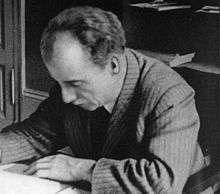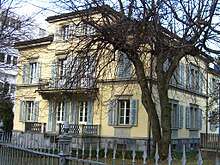Kurt Huber
Kurt Huber (24 October 1893 – 13 July 1943) was a university professor and resistance fighter with the anti-Nazi group White Rose. For his involvement he was imprisoned and guillotined.
Kurt Huber | |
|---|---|
 | |
| Born | 24 October 1893 Chur, Switzerland |
| Died | 13 July 1943 (aged 49) Munich, Germany |
| Nationality | German |
| Occupation | Professor at the University of Munich |
| Known for | White Rose movement |
Early life

Huber was born in Chur, Switzerland, to German parents. He grew up in Stuttgart and later, after his father's death, in Munich. He showed an aptitude for such subjects as music, philosophy and psychology. Huber became a professor of Psychology and Music in 1926 at the Ludwig Maximilian University of Munich.
Resistance
Huber was appalled by the rise of the National Socialist German Workers Party and decided that Hitler and his government had to be removed from power. He came into contact with the White Rose movement through some students who attended his lectures, Hans Scholl and Alexander Schmorell. Huber wrote the White Rose's sixth and final leaflet calling for an end to National Socialism.
Trial and execution
Huber's political activities came to the attention of the Gestapo and he was arrested on 27 February 1943. By coincidence, composer Carl Orff called at Huber’s house the day after he was taken. Huber’s wife begged him to use his influence to help her husband. But Orff told her that if his friendship with Huber was ever discovered he would be “ruined.” Orff left; Huber’s wife never saw him again. Later, wracked by guilt, Orff would write a letter to his late friend Huber imploring him for forgiveness.[1][2] Orff's Die Bernauerin, a project which he completed in 1946 and which he had discussed with Huber before the latter's execution, is dedicated to Huber's memory. The final scene of this work, which is about the wrongful execution of Agnes Bernauer, depicts a guilt-ridden chorus begging not to be implicated in the title character's death.
Huber was brought before the People's Court on 19 April. In a brief show trial, Chief Justice Roland Freisler subjected Huber to a humiliating verbal attack. He was sentenced to death for insurrection. On 13 July, he was executed by guillotine at Munich's Stadelheim Prison, along with Alexander Schmorell. The university had stripped Huber of his position and his doctorate at the time of his arrest. Attempts to take up a collection for Huber's widow Clara only brought about more trouble and eventually led to Hans Leipelt's arrest and execution.
Legacy
The square opposite from the main building of the Ludwig Maximilian University of Munich was named "Professor Huber Platz" in his remembrance. Huber wrote a biography of Gottfried Leibniz which he completed while in prison and which was published in 1951 edited by his wife and pupil.[3] After the war, a memorial volume with contributions from his friends and colleagues, including the 1946 letter from Carl Orff, was published by his widow.[4]
References
- The Sunday Times (subscription required).
- Duchen, Jessica (4 December 2008). "Dark heart of a masterpiece: Carmina Burana's famous chorus hides a murky Nazi past" (PDF). The Independent.
- Leibniz : der Philosoph der universalen Harmonie (Book, 1989) [WorldCat.org]. OCLC 24876923.
- Huber, Clara, ed. (1947). Kurt Huber zum Gedächtnis, Bildnis eines Menschen, Denkers und Forschers, dargestellt von seinen Freunden (in German). Regensburg: Josef Habbel.
External links
- "The White Rose". HEART. 2007. Retrieved 1 June 2016.
- Hornberger, Jacob G. "Holocaust Resistance: The White Rose – A Lesson in Dissent". Jewish Virtual Library. Retrieved 1 June 2016.